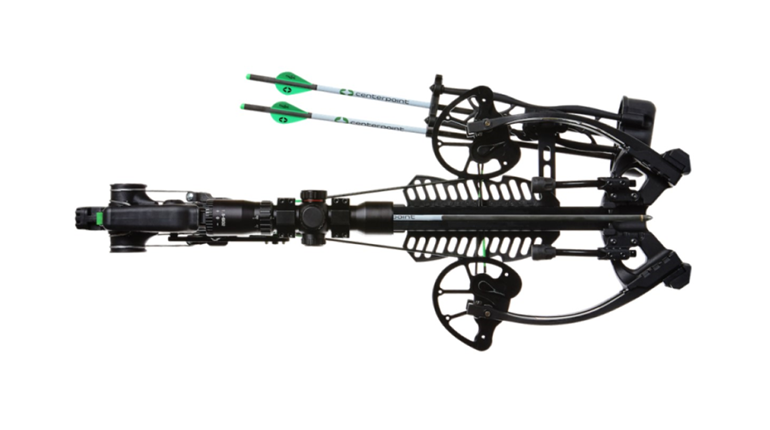
Every once in a while a hunting product comes along that changes the game. Crossbows have evolved big-time since their likely invention by the Chinese sometime around 5 B.C., but thanks to state game agencies making them legal for archery seasons, they’ve probably morphed more in the last 10 years than in the previous 1,000. But they still aren’t perfect. Their cross-like shape is unwieldy in the woods. They’re awfully awkward and difficult to cock for many people, and their flight systems produce friction that decreases the bow’s life. So a group of hunters and investors set out to build the most advanced crossbow ever. What they came up with probably is. The brand is named Ravin, and its initial model is the R9.
In essence, the Ravin R9 is a crossbow with a 190-pound draw weight and a 13-inch powerstroke that sends a 400-grain arrow at 390 fps for 135 ft.-lbs. of kinetic energy. This means the R9 is faster and more powerful than 90 percent of the crossbows currently on the market. But to me what stands out more than its speed is its nimbleness.
Uncocked, the R9 measures 10.5 inches axle-to-axle. But when I hunt I keep a crossbow cocked, and so the measurement that matters most to me is its cocked, cam-edge-to-cam-edge width, which is just 9.25 inches. (Axle-to-axle width when cocked is a mere 6 inches.) That’s the narrowest in the industry. This means the bow is easier to carry up mountains and quieter while slipping through the tangles.
To make a bow this fast and compact was no small feat. Either Ravin could license reverse-draw technology and pay the patent holder royalties, or its engineers could invent a new system. Ravin chose the latter and developed a whole new way of arranging the eccentrics. The company calls its newfound technology HeliCoil.
Instead of using two cables with yokes like conventional crossbows, the R9’s HeliCoil system has four non-split cables. At one end, each cable attaches to the top or bottom side of a cam, rather than to the ends of a cam axle. At the other end, the cable anchors to a square-shaped extension of the riser and stops short of the crossbow’s centerline. The cables wind around the cam axles in helical channels above and below the cams, which rotate 340 degrees, as the crossbow is cocked. This reduces the leverage placed on the cams and applies pressure evenly to the tops and bottoms, thereby reducing cam cant. The design allows the arrow to pass directly down the string’s centerline and through the riser extension while not necessitating that the cables be pulled below the barrel and out of the way—something that can also cause cant.
The design does away with the traditional barrel on which the arrow rides as it’s launched. Instead, the R9 uses a dual-roller arrow rest at the front of the riser, through which the cock vane passes untouched. This system drastically reduces arrow friction and therefore increases speed. And because the string receives zero friction from riding the barrel, its life expectancy should increase. (Ravin recommends replacing the string and cables every two years or 200 shots.) Time will tell, but I’ve tested the system over several months and so far it sure seems legit.
Building a narrow bow creates other challenges, however. Because its string angle while cocked is too acute to handle with conventional cocking aids, Ravin designed a sliding fire-control system called Trac Trigger that cocks the bow, contains an anti-dry-fire device, and engages the trigger sear and safety.
Prior to the R9, I’ve looked askance at cock-by-ratchet-only crossbows because the crank method takes longer than manual cocking, can be noisy and the ratchet handle can get lost. But after shooting the Ravin I’ve come to appreciate it. That’s because Ravin’s cocking system is ambidextrous and can be cranked silently if you keep the ratchet-engagement lever depressed, although the owner’s manual recommends against this technique to avoid knocking your knuckles with the crank handle. In addition, the crank handle is stowed onboard and is not as likely to get lost. The cocking mechanism requires only 10 pounds of force; just about anyone can cock and shoot this bow, even in precarious positions like encountered in treestands. Its design also negates the need for a lengthy foot stirrup. Finally, its crank system ensures arrows, which use proprietary clip-on nocks, are nocked in exactly the same place on the string every time for maximum accuracy.
After some practice I developed a loading technique that works for me. With the quiver placed on the right side of the bow, I crank with my left hand and reload with the right. If I hustle I can be ready to shoot in about 20 seconds. Traditional crossbows cocked with a rope aid take me the same amount of time to ready for shooting.
The R9 shot .78-inch groups at 30 yards. Anything under an inch is phenomenal. No doubt accuracy was helped by one of the best crossbow triggers available. Its pull weight measured 2.32 pounds.
At 6.9 pounds overall, the R9 is lighter than the average crossbow. However, it’s not the quietest, registering 106.9 decibels during my informal sound-meter test.
I like the bow’s quality, molded polymer chassis that promotes safety with its flaring wings and rubber panels that urge the user to grip the bow properly. Its limb configuration creates a pocket that shields much of the broadhead. The bow is 100 percent ambidextrous, and hallelujah, it comes assembled in the box with a scope!
The Ravin R9 represents a noteworthy evolution in crossbow technology. It’s as easy to carry and cock as crossbows come, yet it remains incredibly powerful and accurate. Indeed, it’s a game changer.
Technical Specifications
• Type: compound crossbow
• Draw Weight: 190 lbs.
• Velocity: 390 fps w/400-gr. arrow
• Barrel: machined aluminum
• Riser: machined aluminum
• Stock: molded polymer w/rubber inserts; Predator camo finish; LOP 12.75"
• Trigger: single-stage Trac Trigger Firing System; 2.32-lb. pull weight
• Safety: two-position toggle, automatic, ambidextrous
• Dimensions: length 34.5"; axle-to-axle width 10.5" uncocked, 6" cocked; power stroke 13"
• Weight: 6.9 lbs.
• Accessories: crank cocking device handle, 1.5X-5X-32mm illuminated scope, six Gold Tip arrows w/100-gr. field points, quiver
• MSRP: $1,549





































